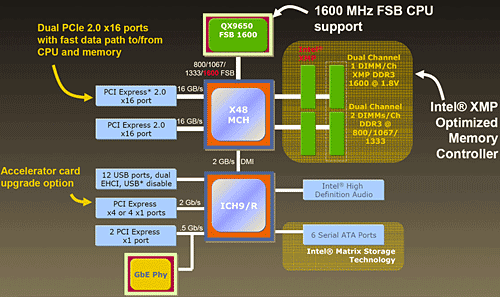Intel Core 2 Extreme QX9770 Performance Preview
X48 Chipset Sneak Peek
As we noted previously, Intel has increased the Core 2 Extreme quad-core's clock speed by incrementally increasing front side bus speed. Along with this FSB boost, they've decided to revise the existing X38 chipset in an effort to better support the higher front side bus speed of the chip. Here's where the new X48 Express chipset comes in. That's not to say that existing X38 boards won't also support the higher 1600MHz FSB of the new Core 2 Extreme QX9770. The product will be supported on a case-by-case basis, depending on the motherboard model, manufacturer and BIOS revision. In fact, all of the benchmarks you'll see here today were taken from an X38 chipset-based motherboard from Asus (P5E3 Deluxe) and things were completely stable at stock 1600MHz FSB speeds and higher.
|
The Intel X48 Express chipset is based on the original X38 design, but is tweaked slightly to better support overclocking, high memory and FSB speeds. As such, it will command a premium in the channel with all manufacturers but for those who want to push their systems and maintain better stability, the X48 will be a better chioce.

As we see here, the X48 chipset is partitioned with its various high speed serial links and local and external IO, identical to what is found on the X38 chipset as well. In addition, Intel pairs the MCH Northbridge up with the same ICH9R Southbridge. Dual X16 PCI Express 2.0 slots are available for graphics and those slots are also backwards compatible, auto-negotiating down to PCIe 1.1 speeds as required. In addition, the MCH still supports up to 4 channels of DDR3 memory but the only difference between this chipset and the X38, is that the MCH now officially supports 1600MHz memory and a synchronous 1600MHz FSB to the processor.
In fact, the new Core 2 Extreme QX9650 is listed in the above block diagram of the X48 chipset. Of course this CPU can also run at the higher 1600MHz bus speed and obviously Intel is actually recommending it here, though the chip was launched with a 1,333MHz FSB as it standard specification. End-users just have to drop the multiplier of the CPU if they want to keep the chip running at its stock core frequency.
As we noted above, all testing for the Core 2 Extreme QX9770 was done on an X38-based P5E3 Deluxe motherboard from Asus. Unfortunately we didn't get the new Asus X48-based P5E3 Premium in house in time for testing in this performance preview of Intel's new high end chip.



Asus P5E3 Premium Motherboard - X48 Express Chipset
Asus P5E3 Deluxe - X38 Express Chipset
If you compare the two boards above, you'll note that they are virtually identical, in terms of layout and features. The only thing that distinguishes the new X48-based Asus P5E3 Premium between its X38-based sibling, is the model name ("Premium" versus "Deluxe") and the newer board's blue color chipset heatsink covers. However, under the hood, the new X48 Express chipset breaths a bit more FSB and memory headroom. Incidentally, clock-for-clock, the X38 will perform nearly identical to the X48 chipset, with only a minor advantage in performance at very high overclock speeds (think the 1800MHz+ range), due to slightly better signal integrity of the chipset in extreme high speed corner cases. Again, the primary benefit of the X48 chipset is stability at high bus speeds.







